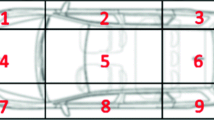Abstract
The problem of workload planning in small lot printed circuit board (PCB) assembly concerns the determination of the daily mix of production orders to be released into the production system. When switching from one production order (board type) to another, a considerable set-up time is incurred based on the number of component feeders to be replaced in the component magazine of the assembly machines. To support the order-mix decision faced by a major electronics manufacturer, two versions of a linear programming model are developed. The models differ primarily in their degree of aggregation and their computational effort. In order to reduce the aggregational error incurred, a fuzzy approach is developed to estimate the number of component set-ups at automatic SMD placement machines. Our numerical investigation reveals that sufficiently accurate solutions may be obtained from a highly aggregate fuzzy LP-model and this is achieved with considerably less computational effort than with a more detailed LP-model. We also demonstrate the potential suitability of the fuzzy LP-model for implementation within an interactive decision support system.
Zusammenfassung
Bei der Kleinserienmontage von Leiterplatten besteht das Problem der Einlastungsplanung darin, ein Tagesprogramm an Produktionsaufträgen zusammenzustellen, die gemeinsam in das Produktionssystem eingeschleust werden. Jeder Produktionsauftrag entspricht einem bestimmten Leiterplattentyp. Wechselt man bei der automatischen Bestückung von Leiterplatten zu einem neuen Leiterplattentyp, so fallen erhebliche Rüstzeiten an, die davon abhängen, wie viele Bauteilezuführungen im Magazin der Bestückungsautomaten ausgewechselt werden müssen. Zur Unterstützung dieses Entscheidungsproblems werden zwei unterschiedliche Modelle der linearen Optimierung entwickelt. Die beiden Modelle unterscheiden sich vor allem durch ihren Aggregationsgrad und ihren Rechenaufwand. Zur Verringerung des Aggregationsfehlers wird ein auf der Fuzzy-Set-Theorie beruhender Ansatz zur Abschätzung der bei automatischen SMD-Bestückungsautomanten auftretenden Rüstzeiten entwickelt. Hierbei wird als industrielles Anwendungsbeispiel die Leiterplattenbestückung in einem bedeutenden Elektronikunternehmen betrachtet. Die durchgeführte numerische Untersuchung zeigt, daß das hochaggregierte Fuzzy-LP-Modell zu hinreichend genauen Lösungen führt und erheblich geringeren Rechenaufwand verursacht als ein detaillierteres LP-Modell. Außerdem wird die praktische Eignung des Fuzzy-LP-Modells für den Einsatz innerhalb eines interaktiven Entscheidungsunterstützungssystems verdeutlicht.
Similar content being viewed by others
References
Ahmadi RH, Kouvelis P (1994) Staging problem of a dual delivery pick-and-place machine in printed circuit card assembly. Oper Res 42:81–91
Askin RG, Dror M, Vakharia AJ (1994) Printed circuit board family grouping and component allocation for a multimachine, open-shop assembly cell. Nav Res Log 41:587–608
Ball MO, Magazine MJ (1988) Sequencing of insertions in printed circuit board assembly. Oper Res 36:192–201
Bard JF, Clayton RW, Feo TA (1994) Machine setup and component placement in printed circuit board assembly. Int J Flex Manuf Syst 6:5–31
Crama Y, Kolen AWJ, Oerlemans AG, Spieksma FCR (1990) Throughput rate optimization in the automated assembly of printed circuit boards. Ann Opers Res 26:455–480
Crama Y, Kolen AWJ, Oerlemans AG, Spieksma FCR (1994) Minimizing the number of tool switches on a flexible machine. Int J Flex Manuf Syst 6:33–54
Deane RH, Moon SH (1992) Work flow control in the flexible flow line. Int J Flex Manuf Syst 3/4:217–235
Grunow M, Günther HO, Gronalt M, Zeller R (1996) A heuristic for component switching on SMD placement machines. Discussion Paper, Technical University of Berlin, Germany
Günther HO, Gronalt M, Piller F (1994) Computergestützte Simulation eines hochautomatisierten Montagesystems (in German). Management & Computer 2:25–32
Günther HO, Gronalt M, Piller F (1995a) A linear programming model for workload planning in printed circuit board assembly. In: Derigs U, Bachem A, Drexl A (eds) Operations Research Proceedings 1994. Springer, Berlin et al., pp. 312–317
Günther HO, Gronalt M, Zeller R. (1995b) Job sequencing and component setup on a surface mount placement machine. Discussion Paper, Technical University of Berlin, Germany
Han MH, McGinnis LF (1988) Throughput rate maximization in flexible manufacturing cells. IIE Transact 20:409–417
Johri PK (1990) A heuristic algorithm for loading new work on circuit pack assembly lines. Int J Prod Res 28:1871–1883
Kusiak A, Cho M (1992) Similarity coefficient algorithms for solving the group technology problem. Int J Prod Res 30:2633–2646
Laporte G (1992) The travelling salesman problem: An overview of exact and approximate algorithms. Eur J Oper Res 59:231–247
Maimon OZ, Dar-El EM, Carmon TF (1993) Set-up saving schemes for printed circuit boards assembly. Eur J Oper Res 70:177–190
McGinnis LF, Ammons JC, Carlyle M, Cranmer L, Depuy GW, Ellis KP, Tovey CA, Xu H. (1992) Automated process planning for printed circuit card assembly. IIE Transact 24:18–30
Sadiq M, Landers TL, Taylor GD (1993) A heuristic algorithm for minimizing total production time for a sequence of jobs on a surface mount placement machine. Int J Prod Res 31:1327–1341
Schneeweiß Ch (1987) On a formalisation of the process of quantitative model building. Eur J Oper Res 29:24–41
Schneeweiß Ch (1995) Hierarchical structures in organisations: A conceptual framework. Eur J Oper Res 86:4–31
Shafer SM, Rogers DF (1993a) Similarity and distance measures for cellular manufacturing. Part I. A survey. Int J Prod Res 31:1133–1142
Shafer SM, Rogers DF (1993b) Similarity and distance measures for cellular manufacturing. Part II. An extension and comparison. Int J Prod Res 31:1315–1326
Tang CS, Denardo EV (1988) Models arising from a flexible manufacturing machine, part I: Minimizing the number of tool switches. Oper Res 36:767–784
van Laarhoven PJM, Zijm WHM (1993) Production preparation and numerical control in PCB assembly. Int J Flex Manuf Syst 5:187–207
Wittrock RJ (1988) An adaptable scheduling algorithm for flexible flow lines. Oper Res 36:445–453
Wittrock RJ (1992) The “Orchard” scheduler for manufacturing systems. Int J Prod Econ 28:47–70
Zimmermann HJ (1991) Fuzzy Sets, Decision Making and Expert Systems. Kluwer, Boston
Author information
Authors and Affiliations
Rights and permissions
About this article
Cite this article
Günther, H.O., Grunow, M. & Schorling, C. Workload planning in small lot printed circuit board assembly. OR Spektrum 19, 147–157 (1997). https://doi.org/10.1007/BF01545517
Received:
Accepted:
Issue Date:
DOI: https://doi.org/10.1007/BF01545517
Key words
- production
- scheduling
- printed circuit board assembly
- modelling
- linear programming
- aggregational error
- decision support




